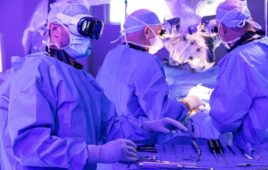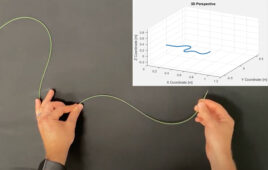In recent years, endoscope reprocessing has emerged as one of the trickiest tasks for healthcare facilities. The devices are in near-constant use, requiring quick turnarounds in getting them cleaned and prepped for the next patient. And yet there are a legion of complexities, many unique to endoscopes, that slow down the process.
By tackling the most significant challenges with intuitive, unique solutions, Medivators, Cantel’s medical division believes it’s bringing valuable efficiency to the process without the slightest compromise to patient safety.
The company’s ADVANTAGE PLUS Pass-Thru Automated Endoscope Reprocessor (AER) officially launched in the U.S. market at the most recent APIC annual conference, where its novel yet logical design stirred excited conversation. That positive chatter has persisted, and the system earned the distinction of finishing as the 2018 ESP Award nominee that generated the most enthusiasm among Surgical Products readers.
The ADVANTAGE PLUS Pass-Thru begins with a simple premise: The AER is essentially embedded in the wall between two rooms, creating a solid separation between the areas where used endoscopes are loaded in and processed devices are removed. The possibility of cross-contamination that can arise from human error is significantly reduced.
The computer in the system, ENDORA, tracks everything as devices proceed through Cantel’s complete circle of protection reprocessing process. The technician or other staff member who places the scope in the AER scans their badge as well as the scope itself, providing critical tracking information.
When the cycle starts, the chamber containing the scope runs a wash cycle and high level disinfection cycle. The wash cycle uses Intercept detergent, which was developed to combat the widest possible array of contaminants. The ENDODRY drying cabinet then dries a scope in about an hour.
Everything is networked together, allowing staff to easily determine when the scope was washed and when it was dried. Robust tracking allows technicians to take a look at the system and know where everything sits in the process.
To learn more, Surgical Products interviewed Darren Dahlin, marketing manager with Cantel’s medical division.
What can you tell us about the ADVANTAGE PLUS Pass-Thru AER?
This is the first pass-thru Automated Endoscope Reprocessor, or AER, on the U.S. market. Up until now, there have been single or dual basin, single-sided machines. The Pass-Thru AER brings a new level of technology and infection prevention to the space.
In the past, rooms were square, machines were all around the edges, and the inside of the room was a cluster of foot traffic. Now we’ve divided that room into a clean side and a dirty side. It’s never happened in the U.S.
This is directly applicable to the endo-suite. It’s also applicable to the OR and the SPD reprocessing areas, because it’s the way the workflow’s always worked in SPD. It’s always been a clean and a dirty and separation with sterile processing. Now we’re moving that technology to endoscopy.
We know reprocessing of flexible endoscopes is number two on the ECRI data for the most dangerous things to watch for in hospitals right now. Number one is IT, data security. Number two is reprocessing of flexible endoscopes.
The significant part of this is taking some of the human element out to assure that our scopes are being reprocessed correctly by separating the clean from dirty.
What is the process like?
The first thing a user or technician would see is a complete separation of rooms. The scope goes in the machine on one side, and it comes out the other side of the machine in an adjacent room as a clean scope. It’s a hard wall separation between these two areas.
On one side you have a sink where you wash the endoscope, and you leak test your manual washing. The device is put into the Pass-Thru automated endoscope reprocessor. In there, it gets cleaned and a clean scope comes out on the other side of the wall. Now it can be put into a dryer to be dried for the next patient.
Most importantly, the ADVANTAGE PLUS Pass-Thru AER delivers a hard wall of separation between these two rooms to help ensure there’s no cross-contamination.
Hennepin Healthcare, located in Minneapolis, was the first facility in the U.S. to install the ADVANTAGE PLUS Pass-Thru AER.How does the ADVANTAGE PLUS Pass-Thru address some of the particular concerns around getting scopes properly cleaned?
An endoscope is a very technologically complex device. And it’s a challenge to get these cleaned day after day. The chemistry is second to none, the processes we implement are second to none, and this device is the same – ithelps facilities reduce time and increase effectiveness to get these scopes clean.
A lot of facilities are reprocessing 30, 40, 50 scopes a day and that’s a lot of repetitive work. And the repetitive work is where you’re most apt to make mistakes. Generally speaking, these folks get tired, the work is hard and it’s a hot environment, often creating a less desirable environment to work in. And we recognize that, so we’re trying to make this process as simple for them as possible. We want it be a simple process across the board, where we can track the endoscopes and we can verify they’re getting clean.
It’s one thing to get into an endoscope clean. We then need to keep it clean and dry for the next patient. We’re the only company in this country and worldwide that covers the full gamut of infection prevention within endoscopy, from patient to patient. Some people dabble in different sections of it. But Cantel’s medical division is the only company that offers a solution for every scope, every step of the way.
What other support do you provide to healthcare facilities?
We also offer CE-accredited educational programs for our facilities to insure that everybody’s on the same page. It’s one thing to educate a tech on how to scrub a scope. It’s another thing to let them believe in why they’re doing it and why it’s important, where this falls in the grander scheme of reprocessing, patient safety, and infection prevention.
And it’s not just the scope tech. It’s the endo-manager, it’s the infection preventionist, it’s purchasing, it’s the biomed in the facilities. Everybody needs to understand the importance of quality endoscope reprocessing and how to support it properly.
Endodry cabinets at Hennepin Heathcare.Since this is built on technology that users should find at least somewhat familiar, are you finding the adoption of the new system is relatively easy?
Yes, especially if they’re using some of our current technology. We built it out with that in mind.
This Pass-Thru AER ties in with our drying cabinet and our transport systems. You can put a scope in one of our cassettes — it’s like a small basket — and you don’t take that scope out until it either goes into the physician’s hands or it goes to the sink to get washed. So what that means is we’ve also eliminated the human aspect of handling scopes between patients and in between rooms.
It also reduces the damage to the scopes. Damage is the number one reason to have a dirty, infected scope, because you can’t effectively clean a damaged scope. This gives us a hands-free way to handle scopes, to transport scopes from our Pass-Thru AER to our drying cabinets to our patients and then back to the sink. We’re reducing close to 80 percent of the damage that happens to scopes.
What other safeguards are built into the system?
Consider the leak testing and all the other damage tests we do. The Pass-Thru AER itself does a leak test to make sure the scope is clean and safe.
Then the scopes goes into our drying cabinets, which are also hands-free and use the same cassettes. Scopes never touch another scope in our process. That’s a critical piece of this. We’re not cross contaminating any of these scopes in this process.
And when they’re stored, they’re stored contained. So they’re not touching scopes, they’re not hanging on the floor of a cabinet, they’re not swinging on a wall.
We really control the scope the whole process, and it creates this workflow that can be universal throughout a facility. It can be adopted for other departments. For example, if I’m a technician or I’m a manager and I go to another facility to help them on a busy day or something like that, I can pick right up on where they are because I know their process and I know how it works.
That’s the efficiency we’re trying to build into GI and endo-reprocessing, which doesn’t really exist right now.




